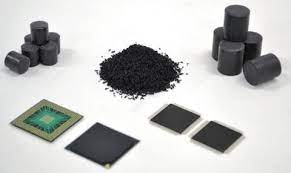- Home
- Products
- Elementary
- Boride Powder
- 3D Printing Powder
- Sulfide Powder
- Oxide Powder
- Carbide powder
- Nitride Powder
- Silicide Powder
- Hydride Powder
- Telluride Powder
- Selenide Powder
- Stearic Acid Series
- Phosphide Powder
- Nanoparticles
- Metal Alloy
- MAX Phase
- Lithium Battery Anode
- Surfactant
- Molecular sieves
- Concrete Admixtures
- News
- Answers
- Contact
- About
News
- 1
- 1
Research on the epoxy plastic encapsulant industry for semiconductors
If you are looking for high-quality products, please feel free to contact us and send an inquiry, email: brad@ihpa.net
EMC (epoxy molding compound) is a semiconductor packaging material used in most application semiconductor end products, such as general household appliances such as mobile phones, refrigerators and TVs, industrial equipment, and automobiles. With the development of IT technology and electronic products based on modern technology, the global semiconductor market continues to expand, and EMC demand continues to increase.
According to the latest report of the QYResearch research team, "Global Semiconductor Epoxy Plastic Encapsulation Market Report 2023-2029", the global semiconductor epoxy plastic encapsulation market is expected to reach US$3.17 billion in 2029, with a compound annual growth rate of CAGR of 4.7 in the next few years. %.
In terms of product types, solid EMC is currently the most crucial segmented product, accounting for approximately 78.5% of the market share. Currently, discrete devices are the primary source of demand, accounting for about 28.1% of the market share.
Main drivers
Many companies have developed new flame retardant technologies for epoxy encapsulants used in semiconductors. This product uses a particular "silicone flame retardant system" to replace the antimony compounds and brominated epoxy resins used in the past. In recent years, due to environmental considerations, there has been a trend in the semiconductor industry to use non-halogen materials (green compounds) that do not contain antimony or bromine. This system is an environmentally friendly technology that anticipates this trend. The demand for molding compounds using new systems is expected to increase in the future.
In recent years, as electronic products have been increasingly used in automobiles, the number of built-in semiconductors has also increased.

1) The establishment of built-in semiconductor reliability test standards (such as AEC-Q100) has relatively stricter conditions.
2) In order to pass rigorous reliability tests, such as b-HAST (biased highly accelerated stress test), it is necessary to reduce the delamination of the epoxy molding compound on the surface of the lead frame. Reflow soldering process.
In addition, to reduce costs, we need to eliminate moisture-proof packaging not only for built-in semiconductors but also for consumer semiconductors. Therefore, we need to increase the moisture sensitivity level (MSL) of water absorption during reflow soldering.
At the same time, traditional gold wires have been replaced by copper wires to reduce costs, although the latter are more susceptible to corrosion than the former. Regarding the use of copper wire, we already know that additives containing sulfur atoms used to improve adhesion to the lead frame can adversely affect corrosion in the wire bond area.
3) Therefore, additives that do not contain sulfur atoms are required.
With the development of specialization and scale of packaging companies, EMC production will also develop towards large-scale, lead-free, environmentally friendly, high-tech, and low-cost production in the future.

Main hindrance factors
Supply relations are tense, the industrial chain is relatively closed, risks are high, and it is difficult for new entrants to enter the supply chain.
Core technologies are mainly in the hands of top manufacturers. They apply for patent protection for technologies and critical components and have a strong sense of confidentiality for the core components they produce, creating technical barriers for new entrants.
The manufacturers' comprehensive technical strength, product development capabilities, and all-around service capabilities will be more stringent.
Industry development opportunities
Epoxy encapsulants (EMC) are widely used in the electronics industry to encapsulate and protect semiconductor devices. With the continuous advancement of electronic equipment and the increasing demand for miniaturization, the demand for EMC is also growing.
The current trend is to use high-performance epoxy molding compounds to provide better thermal conductivity, electrical insulation, and mechanical properties. In addition, there is an increasing emphasis on lightweight materials to meet the requirements of industries such as automotive and aerospace.
Environmental concerns and regulations have led to increased focus on sustainable materials across industries, including the electronics industry. Manufacturers are exploring epoxy molding compounds with improved environmental properties, such as low volatile organic compound (VOC) emissions and recyclability.
Spherical Silica Powder Supplier
Synthetic Chemical Technology Co. Ltd., is an established global chemical material manufacturer and supplier with over 12 years' experience in the production of high-quality nanomaterials.
We provide Lithium Battery Anode Material, nickel-based superalloy powders such as Inconel 718, Inconel 625, CoCrMo, CoCrW and other cobalt alloy powders, Ti6Al4V and other titanium alloy powders, AlSi10Mg, AlSi7Mg and other aluminium alloy powders, SS316L, H13, 18Ni300 and other ferroalloy powders, stainless steel powder, CuSn10, etc. 3D printing powder. Contact us via message or select the desired items to send us an inquiry.(sales5@nanotrun.com)
Inquiry us
